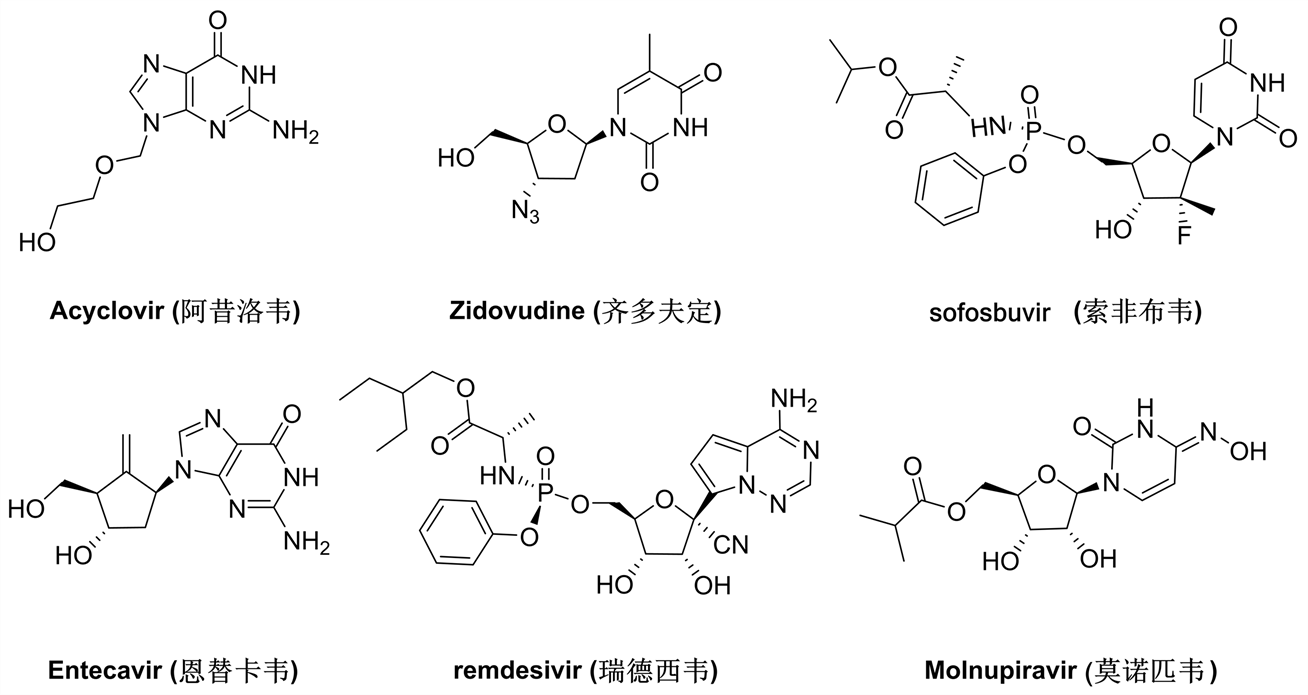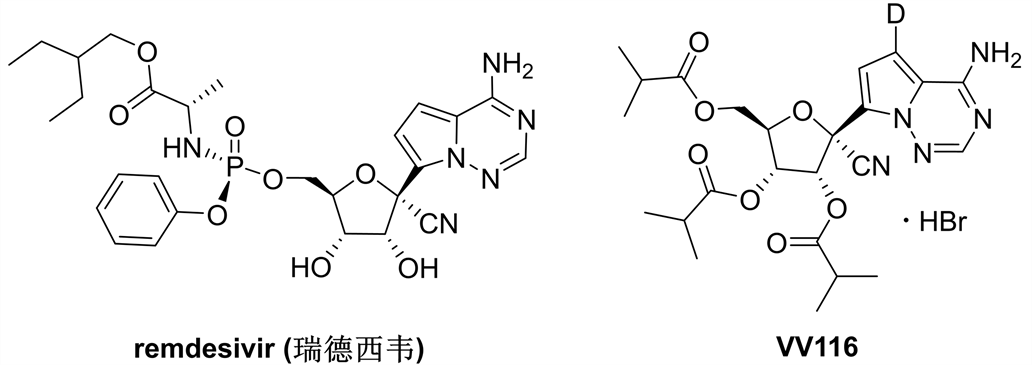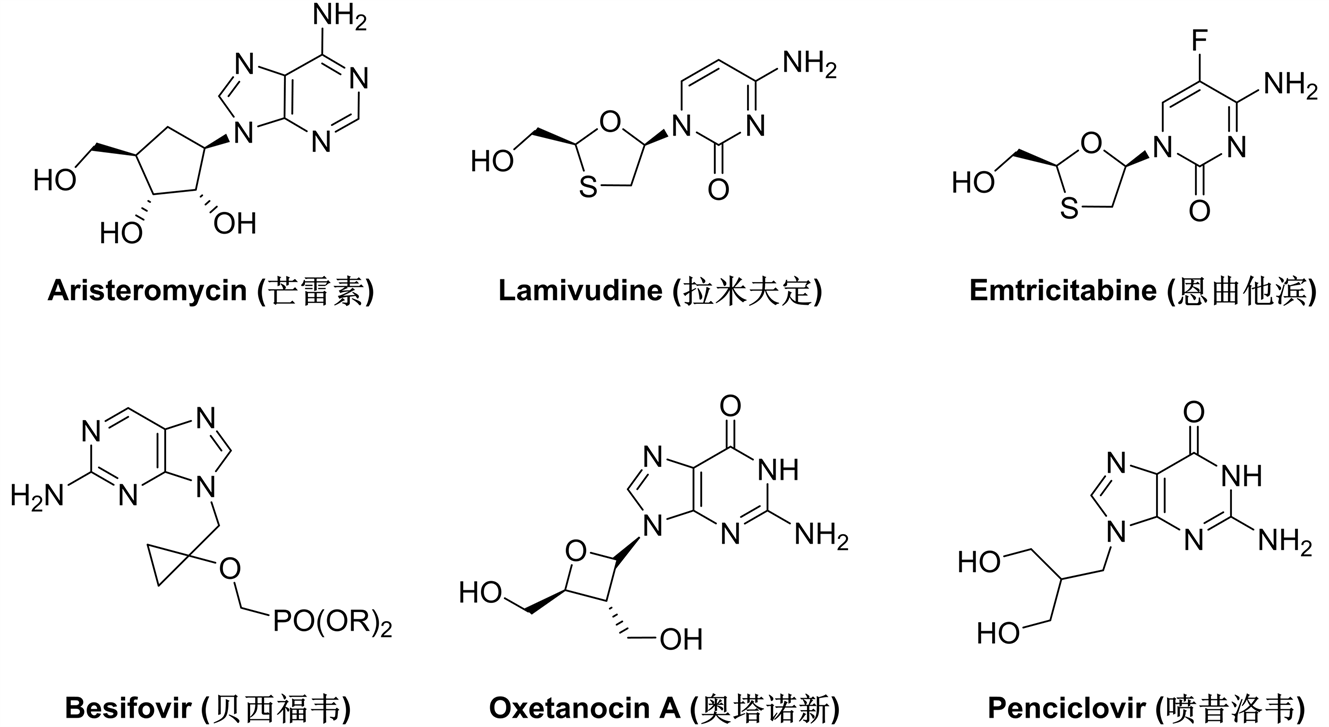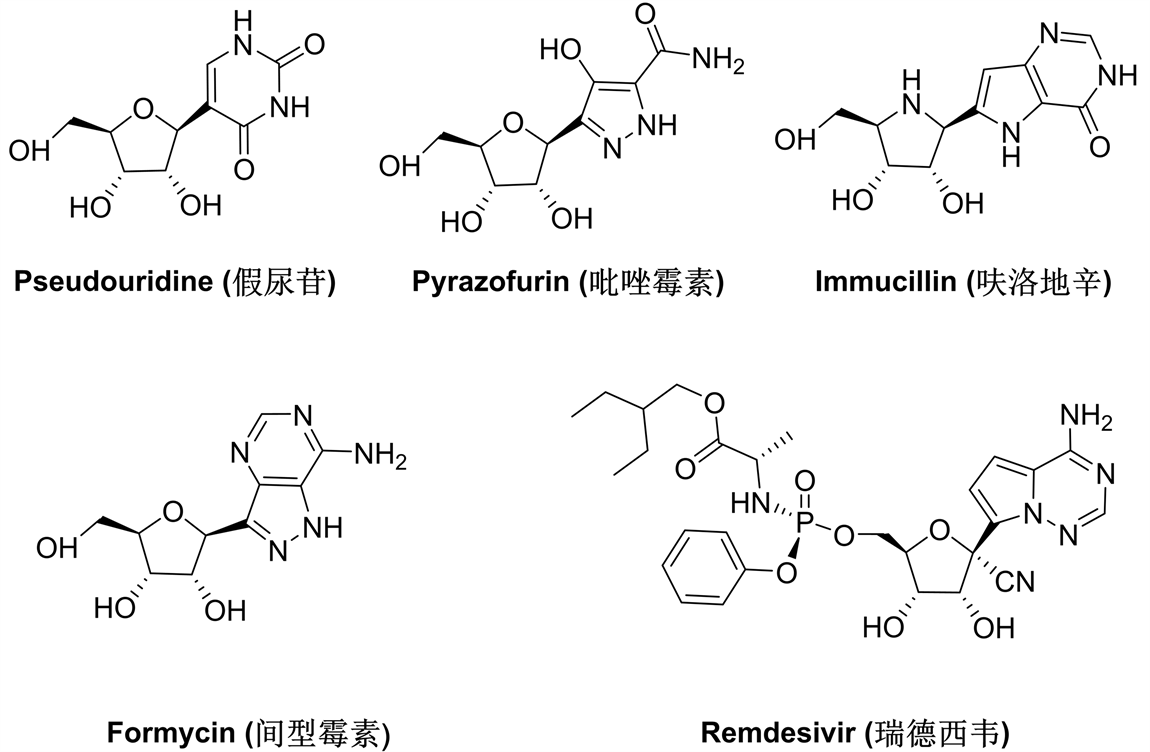Hans Journal of Medicinal Chemistry
Vol.
11
No.
03
(
2023
), Article ID:
70098
,
9
pages
10.12677/HJMCe.2023.113018
核苷类抗病毒药物的研究进展
王梦瑶1,曹凌峰2,万坤1,张磊1*
1浙江师范大学化学与材料学院,浙江 金华
2浙江合糖科技有限公司,浙江 金华
收稿日期:2023年5月17日;录用日期:2023年5月23日;发布日期:2023年8月3日

摘要
核苷类似物是在临床上广泛使用的一类抗病毒和抗肿瘤药物,在特异性治疗以及广谱抗病毒领域都发挥着至关重要的作用。但在临床使用过程中出现的耐药性、毒性和二重感染等问题给该类药物的发展带来挑战。研究发现通过化学修饰可以影响核苷的抗病毒效力、安全性和耐药性。本文概述了以传统核苷类化合物的结构为基础,从碱基、糖环、磷酸基及糖苷键等几个方面进行结构修饰的研究进展,为进一步开发高抗病毒活性核苷类似物提供借鉴。
关键词
抗病毒药物,核苷类似物,抗病毒,生物活性

Research Progress in Nucleoside Antiviral Drugs
Mengyao Wang1, Lingfeng Cao2, Kun Wan1, Lei Zhang1*
1College of Chemistry and Materials Science, Zhejiang Normal University, Jinhua Zhejiang
2Zhejiang Synose Tech Co., Ltd, Jinhua Zhejiang
Received: May 17th, 2023; accepted: May 23rd, 2023; published: Aug. 3rd, 2023

ABSTRACT
Modified nucleosides are a major class of anti-virus and anti-tumor drugs, which are widely used in the clinic. However, issues including the emergence of drug resistance, toxicity and superinfection have posed new challenges for nucleoside-based antiviral drug discovery. Many research found that chemical manipulation could impact the antiviral potency, safety, and drug resistance of nucleosides. This article provides an overview of modification of traditional nucleoside framework in order to provide reference for further research and development of highly antiviral nucleoside analogues.
Keywords:Antiviral Drugs, Nucleoside Analogue, Antiviral, Biological Activity

Copyright © 2023 by author(s) and Hans Publishers Inc.
This work is licensed under the Creative Commons Attribution International License (CC BY 4.0).
http://creativecommons.org/licenses/by/4.0/


1. 引言
病毒感染类疾病是指对人体有治病作用的病毒通过多种传播途径如呼吸道、母婴、血液传播等进入到人体,然后在人体细胞内增殖,因病毒的类型不同会对人体造成不同程度的损伤或引起疾病,严重的可危及生命。例如人体免疫缺陷病毒(HIV),由于该病毒可以损害人体免疫系统内的T淋巴细胞,造成大量的淋巴细胞死亡,人体的免疫力日渐下降,最终失去免疫能力,接下来人体变得非常脆弱特别容易感染疾病,甚至可以引起癌症,死亡率比较高。因此,抗病毒类药物的研究和发展对于提升全世界人类健康水平来说具有重要意义。根据作用机制的不同,抗病毒药物大致可分为靶向病毒自身和靶向宿主两类 [1] [2] 。靶向病毒药物是针对病毒复制过程中,可以有效阻断病毒RNA链延伸,提前终止病毒复制,从而实现抗病毒的作用。其中核苷类药物是该类抗病毒药物的主要代表,已经上市的抗病毒药物中,约有50%为此类药物,如治疗疱疹的阿昔洛韦(图1),第一种治疗艾滋病的齐多夫定,治疗乙肝的恩替卡韦,治疗慢性丙肝的索菲布韦,以及抗新冠病毒药物瑞德西韦与莫诺匹韦等 [3] 。

Figure 1. Several nucleoside antiviral drugs used in clinical therapy
图1. 已用于临床治疗的几种抗病毒核苷药物
由于病毒不断的变异和新病毒的不断出现,人类依然面临着许多病毒感染性疾病的威胁,因此研究开发高效、低毒、生物利用度高的新型核苷类药物,为治疗病毒感染性疾病以及应对未来类似于COVID-19这种新发病毒感染是至关重要的。
2. 核苷类似物的结构修饰
抗病毒核苷类药物都是非天然核苷,主要通过修饰天然核苷的碱基或糖环部位及双重修饰获得。经过修饰后的核苷药物与病毒聚合酶的核苷结构具有高度的相似性,可以竞争性的与病毒聚合酶结合,降低酶活性,阻断病毒的复制,终止病毒RNA链的延伸,从而对病毒产生选择性的抑制作用 [4] 。下面我们将对核苷的修饰简要介绍。
2.1. 碱基部分的修饰
核苷类似物中酶–配体的识别和结合涉及到与不同类型碱基的相互作用,在与模板碱基错配后可抑制病毒的复制,从而对病毒产生抑制作用。因此,改变碱基的位阻、电子或氢键的相互作用也会显著影响生物识别。对碱基部分的修饰是对核苷类似物的嘌呤和嘧啶碱基进行修饰,主要集中在向碱基上添加取代基、去除或添加原子或改变原子的位置。
2.1.1. 嘧啶碱基5-位修饰
核苷药物设计中最为常见的修饰就是在嘧啶环的-5位上添加取代基。如用于治疗疱疹性角膜炎的碘苷(图2)就是通过在嘧啶环的5-位添加碘取代基,这种修饰可以潜在地改变位阻、电子效应,甚至是酶结合点和核苷类似物之间的氢键相互作用 [5] [6] 。同样还有在嘧啶环5-位添加三氟甲基用于眼部疱疹感染的曲氟尿苷 [7] ,以及在5-位添加溴乙烯基用于治疗带状疱疹病毒的溴夫定等 [8] 。另外,氟碘阿糖尿苷(FIAU)也是一种核苷类抗病毒药物,主要对人类免疫缺陷病毒(HIV)、疱疹病毒、巨细胞病毒(CMV)和乙型肝炎病毒(HBV)等病毒有作用 [9] 。

Figure 2. 5-Modified pyrimidine nucleoside analogues
图2. 嘧啶环5-位修饰的核苷类似物
2.1.2. 杂环碱基的改造
研究发现在碱基上去除或添加一个强氢键的供体或受体会影响核苷类似物的性质。如通过将嘌呤3-位上的N原子被CH取代而制备的3-去氮-脱氧尿苷(图3),它不仅能够提高对DNA和RNA病毒的广谱抗病毒活性,还能有效抑制白血病L210和P388细胞株 [10] 。另外在碱基中添加氮原子可以引入新的氢键结合体或受体,增加反应活性。如5-氮杂胞苷,氮的添加赋予了新的抗癌活性,特别是对急性骨髓性白血病和MCF-7人类乳腺癌乙基骨髓增生异常综合征的治疗 [11] 。同时也可将碱基直接换位其他杂环,如用1,2,4-三唑环代替传统碱基而制备的新型核苷类似物利巴韦林,它进入人体后不易被核苷酶或核苷磷酸化酶水解 [12] 。另外,其独特的结构使其可与生物体内的多种生物大分子相互作用(配位键、氢键、π-π堆积、疏水性和范德华力等)。它属于次黄嘌呤核苷脱氢酶(IMPDH)抑制剂,通过降低鸟苷酸水平而具有抗病毒的作用,对多种RNA和DNA病毒有效,是核苷类药物发展中的一个重要里程碑,具有广谱的抗病毒活性 [13] 。

Figure 3. Heterocyclic base moiety modified nucleoside analogues
图3. 杂环碱基改造的核苷类似物
2.2. 糖环部分的修饰
糖环上的修饰包括在呋喃糖环上引入或去除基团,改变环的大小,去除呋喃糖环上的氧原子以其他原子取代,甚至只保留碱基生成全新的核苷类似物。糖环结构的修饰不仅可以提高其抗病毒活性,还有可能在一定程度上降低其毒性,改善药效学和药动力学性质 [4] 。
2.2.1. 1'-位修饰
瑞德西韦(图4)是由Gilead公司、美国疾病控制和预防中心(CDC)美国陆军传染病医学研究所(USAMRIID)于2017年合作开发的。结构活性关系表明:1'-氰基类似物表现出更广泛的抗病毒活性,对HCV、埃博拉病毒(EBOV)、黄热病病毒(YFV)、流感病毒、登革热-2病毒(DENV-2)和急性呼吸中和征冠状病毒(SARS-CoV)都有很好的活性。早在2020年新冠疫情爆发之初,被誉为“人民的希望”的瑞德西韦就曾凭借在COVID-19住院患者中显示的疗效,先后获得美国、欧洲和日本等紧急授权或完全批准 [14] 。VV116由中国科学院上海药物研究所、中国科学院武汉病毒研究所、旺山旺水生物医药有限公司等多家机构联合开发。临床前研究显示,VV116在体内外都表现出显著的抗SARS-CoV-2作用,对SARS-CoV-2原始株和已知重要变异株(Alpha、Beta、Delta和Omicron)均表现出抗病毒活性,同时具有很高的口服生物利用度和良好的化学稳定性 [15] 。

Figure 4. 1'-Modified nucleoside analogues
图4. 1'-位修饰的核苷类似物
2.2.2. 2'-位修饰
2'-位的改造通常是将2'-羟基构型翻转乙基引入取代基或着脱羟基等。阿糖胞苷(Ara-C) (图5)于1969年被批准用于临床,主要作为细胞S增殖期的嘧啶类抗代谢药物,主要通过抑制DNA聚合酶的活性及相应DNA的合成来阻断病毒的复制 [16] 。阿糖腺苷(Ara-A)于1976年被美国FDA批准用于治疗单纯疱疹性脑炎、新生儿单纯疱疹和带状疱疹,也被用于水痘–带状疱疹病毒(VZV)感染、婴儿先天性巨细胞病毒感染的治疗 [17] 。人们在研究2'-氟核苷时发现2'-脱氧-2'-氟胞苷对HCV具有很好的抑制作用,并且在100 µM范围内无细胞毒性。索菲布韦是一种2'-脱氧-2'-氟-2'-甲基尿苷类似物,在2013年被FDA批准用于治疗丙肝 [18] 。

Figure 5. 2'-Modified nucleoside analogues
图5. 2'-位修饰的核苷类似物
2.2.3. 3'-位修饰
3'-位修饰通常会增强其抗肿瘤的活性,人们研究发现3'-甲基腺苷(图6)对白血病和结肠癌及乳腺癌细胞系具有良好的抑制作用 [19] 。后来Mikhailopulo等人在核苷类似物3'-位引入氟原子,合成了一些列3'-脱氧-3'-氟核苷类似物,表现出良好的抗肿瘤活性及广谱的抗病毒活性。其中3'-脱氧-3'-氟鸟苷对牛痘病毒、柯萨奇病毒、塞姆利基森林病毒和辛德比斯病毒的抑制作用为3'-脱氧-3'-氟腺苷活性的10倍 [20] 。

Figure 6. 3'-Modified nucleoside analogues
图6. 3'-位修饰的核苷类似物
2.2.4. 2'和3'-位同时修饰
大量研究显示如果核苷类似物缺少3'-位羟基或被其他基团取代,可对病毒DNA链的合成和延长有抑制作用,从而可作为核酸链的终止剂。如司他夫定(图7),具有2',3'-不饱和结构,缺少的3'-位羟基可作为链终止剂,现已被用于治疗HIV [21] 。同样FDA批准的第一个用于治疗HIV的核苷类药物齐多夫定的3'-叠氮基为线性结构,与天然核苷相容并具有较小的位阻和电负性。这种结构可以提高核苷的稳定性。后来又陆续发展了扎西他滨,地达诺新,拉米夫定及恩曲他滨等抗病毒药物 [22] 。

Figure 7. 2',3'-Modified nucleoside analogues
图7. 2'和3'-位同时修饰的核苷类似物
2.2.5. 4'-位修饰
4'-位取代也是核苷类化合物的一类重要修饰,通常引入乙炔基、氰基、叠氮基等,不仅可以提高其对酶和酸的稳定性,还使其更具亲脂性,从而可以提高其细胞的通透性和生物利用度 [23] 。阿兹夫定(图8)已用于治疗HIV感染,还用于治疗COVID-19,且疗效优于瑞德西韦。另外,据文献报道4'-Ed4T是一种新型胸苷类似物,它比司他夫定具有更强的抗HIV-1活性,且在细胞实验中表现出比齐多夫定和司他夫定更为持久的抗HIV活性 [24] 。Islatravir是一种高效的HIV-RT易位抑制剂,目前正在临床评估单独使用或与其他抗逆转录病毒药物联合使用对HIV-1的治疗或预防,Islatravir也能有效抑制HBV [25] 。罗氏公司开发的4'-叠氮胸苷(ADRT)是一种有效的基于核苷的RNA定向DNA聚合酶抑制剂,用于治疗HIV感染 [26] 。

Figure 8. 4'-Modified nucleoside analogues
图8. 4'-位修饰的核苷类似物
2.2.6. 5'-位修饰
核苷在体内通常需要转化为5'-三磷酸的活性底物,而单磷酸的形成是限速步骤。因此大多数的5'-位修饰都集中在5'-位的磷酸化上。目前较为有效的核苷前药是磷酰胺前药和脂质共轭磷酸酯前药,如索菲布韦(图9)和瑞德西韦就是一类单磷酸核苷前药 [14] [18] 。

Figure 9. 5'-Modified nucleoside analogues
图9. 5'-位修饰的核苷类似物
2.2.7. 糖环部分其他的修饰
核糖环上的氧原子可以被C、S、Se等原子取代,如用C代替核糖环上O的碳环核苷芒雷素(图10),发现其对麻疹流感牛痘病毒和水泡型口腔炎等病毒具有较强的抗病毒活性 [27] 。除此之外,抗病毒药物拉米夫定和恩曲他滨也是糖环中的3'-位C被S取代的一类核苷 [22] 。另外,研究发现当呋喃糖环单元被特定的三元碳环、四元碳环或含羟基的链状片段所取代时,仍能表现出很好的抗病毒活性。如贝西福韦,奥塔诺新, 喷昔洛韦等 [28] [29] 。
2.3. 糖苷键的修饰
研究发现N-核苷结构不稳定,容易被核苷酶或核苷磷酸化酶水解而失去生物活性,而C-核苷具有一个明显的优势即不易被核苷酶或核苷磷酸化酶水解,因此人们逐渐对开发C-核苷类药物产生了极大的兴趣 [30] 。假尿苷(图11)是第一个在tRNA中发现大量存在的天然C-核苷。之后也可以从人尿中获得,肿瘤患者的尿液中假尿苷的含量均超过正常人的数值,因此现在通过检测其含量可诊断肿瘤 [31] 。吡唑霉素于1969年从白色链霉菌分离得到的C-核苷类似物,结构类似于利巴韦林,通过抑制尿苷5'-磷酸合酶抑制细胞增殖和细胞内DNA的合成,既具有抗病毒活性也有抗肿瘤活性 [32] 。Formycin A是一种嘌呤核苷抗生素,一种有效的HIV-1的抑制剂,并具有抗肿瘤和抗病毒的活性 [33] 。呋洛地辛不仅是C-核苷类似物,还是亚胺糖,与呋喃糖相比增加了与酶结合位点的相互作用。它是一种高效的嘌呤核苷磷酸化酶抑制剂,并具有抗T细胞急性淋巴细胞白血病和皮肤T细胞淋巴瘤的临床效用 [34] 。另外,前面介绍的用于COVID-19治疗的瑞德西韦也属于C-核苷。

Figure 10. Sugar rings modified nucleoside analogues
图10. 糖环修饰的核苷类似物

Figure 11. Glycosidic bond modified nucleoside analogues
图11. 糖苷键修饰的核苷类似物
3. 总结
核苷类似物是在临床上广泛使用的一类抗病毒和抗肿瘤药物,但大多天然核苷及其类似物存在脂溶性差、毒性大及耐药性等问题。通过化学修饰可以影响核苷的抗病毒效力、安全性和耐药性,这也是药物化学领域的研究热点。本文从碱基、糖环、磷酸基及糖苷键等几个方面总结了核苷类似物结构修饰的研究进展,为进一步开发高抗病毒活性核苷类似物提供借鉴。
基金项目
浙江省金华市科技计划项目“核苷类抗新冠药物关键中间体的合成工艺研究”(项目编号:2022-4-045)。
文章引用
王梦瑶,曹凌峰,万 坤,张 磊. 核苷类抗病毒药物的研究进展
Research Progress in Nucleoside Antiviral Drugs[J]. 药物化学, 2023, 11(03): 139-147. https://doi.org/10.12677/HJMCe.2023.113018
参考文献
- 1. Kausar, S., Khan, S.F., Ur Rehman, M.I.M., et al. (2021) A Review: Mechanism of Action of Antiviral Drugs. Interna-tional Journal of Immunopathology and Pharmacology, 35, Article ID: 20587384211002621. https://doi.org/10.1177/20587384211002621
- 2. Quan, D.J. and Peters, M.G. (2004) Antiviral Therapy: Nucleo-tide and Nucleoside Analoga. Clinics in Liver Disease, 8, 371-385. https://doi.org/10.1016/j.cld.2004.02.012
- 3. Lin, X., Liang, C., Zou, L., et al. (2021) Advance of Structural Modification of Nucleosides Scaffold. European Journal of Medicinal Chemistry, 214, Article ID: 113233. https://doi.org/10.1016/j.ejmech.2021.113233
- 4. Peter, H.L., Ku, T.C. and Seley-Radtke, K.L. (2015) Flexibility as a Strategy in Nucleoside Antiviral Drug Design. Current Medicinal Chemistry, 22, 3910-3921. https://doi.org/10.2174/0929867322666150818103624
- 5. Prusoff, W.H. (1959) Synthesis and Biological Activi-ties of Iododeoxyuridine, an Analog of Thymidine. Biochimica et Biophysica Acta, 32, 295-296. https://doi.org/10.1016/0006-3002(59)90597-9
- 6. De Clercq, E. (2010) Historical Perspectives in the Develop-ment of Antiviral Agents aganist Poxviruses. Viruses, 2, 1322-1339. https://doi.org/10.3390/v2061322
- 7. Bridges, C.G., Ahmed, S.P., Sunkara, P.S., McCarthy, J.R. and Tyms, A.S. (1995) The Ribonucleotide Reductase Inhibitor (E)-2’-Fluoromethylene-2’-Deoxycytidine: A Potential Topical Therapy for Herpes Simplex Virus Infection. Antiviral Research, 27, 325-334. https://doi.org/10.1016/0166-3542(95)00015-E
- 8. De Clercq, E., Descamps, J., De Somer, P., et al. (1979) (E)-5-(2-Bromovinyl)-2’-Deoxyuridine: A Potent and Selective Anti-Herpes Agent. Proceedings of the National Acade-my of Sciences of the United States of America, 76, 2947-2951. https://doi.org/10.1073/pnas.76.6.2947
- 9. Staschke, K.A., Colacino, J.M., Mabry, T.E. and Jones, C.D. (1994) The in Vitro Anti-Hepatitis B Virus Activity of FIAU[1-(2’-Deoxy-2’-Fluoro-1-β-D-Arabinofuranosyl-5-Iodo) Uracil] Is Selective, Reversible, and Determined, at Least in Part, by the Host Cell. Antiviral Research, 23, 45-61. https://doi.org/10.1016/0166-3542(94)90032-9
- 10. Mian, A.M. and Khwaja, T.A. (1983) Synthesis and Anti-tumor Activity of 2-Deoxyribofuranosides of 3-Deazaguanine. Journal of Medicinal Chemistry, 26, 286-291. https://doi.org/10.1021/jm00356a034
- 11. Chang, H.-W., Wang, H.-C., Chen, C.-Y., et al. (2014) 5-Azacytidine Induces Anokis, Inhibits Mammosphere Formation and Reduces Metalloproteinase 9 Activity in MCF-7 Human Breast Cancer Cells. Molecules, 19, 3149-3159. https://doi.org/10.3390/molecules19033149
- 12. Zhou, C.-H. and Wang, Y. (2012) Recent Researches in Triazole Compounds as Medical Drugs. Current Medicinal Chemistry, 19, 239-280. https://doi.org/10.2174/092986712803414213
- 13. Sabat, N., Migianu-Griffoni, E., Tudela, T., et al. (2020) Syn-thesis and Antitumor Activities Investigation of a C-Nucleoside Analogue of Ribavirin. European Journal of Medicinal Chemistry, 188, Article ID: 112009. https://doi.org/10.1016/j.ejmech.2019.112009
- 14. Dan Do, T.N., Donckers, K., Vangeel, L., et al. (2021) A Ro-bust SARA-CoV-2 Replication Model in Primary Human Epithelial Cells at the Air Liquid Interface to Assess Antiviral Agents. Antiviral Research, 192, Article ID: 105122. https://doi.org/10.1016/j.antiviral.2021.105122
- 15. Xie, Y., Yin, W., Zhang, Y., et al. (2021) Design and Devel-opment of an Oral Remdesivir Derivative VV116 against SARS-CoV-2. Cell Research, 31, 1212-1214. https://doi.org/10.1038/s41422-021-00570-1
- 16. Tosh, D.K., Janowsky, A., Eshleman, A.J., et al. (2017) Scaf-fold Repurposing of Nucleosides (Adenosine Receptor Agonists): Ehhanced Activity at the Humann Dopamine and Nerepinephrine Sodium Symporters. Journal of Medicinal Chemistry, 60, 3109-3123. https://doi.org/10.1021/acs.jmedchem.7b00141
- 17. Suzuki, M., Okuda, T. and Shiraki, K. (2006) Synergistic An-tiviral Activity of Acyclovir and Vidarabine against Herps Simplex Virus Types 1 and 2 and Varicella-Zoster Virus. An-tiviral Research, 72, 157-161. https://doi.org/10.1016/j.antiviral.2006.05.001
- 18. Müller, H., Gabrielli, V., Agoglitta, O. and Holl, R. (2016) Chiral Pool Synthesis and Biological Evaluation of C-Furanosidic and Acyclic LpxC Inhibitors. European Journal of Medicinal Chemistry, 110, 340-375. https://doi.org/10.1016/j.ejmech.2016.01.032
- 19. Costanzi, S., Lambertucci, C., Portino, F.R., et al. (2005) Ring Opening Reactions: Synthesis of AICAR Analogs as Potential Antimetabolite Agents. Nucleosides, Nucleotides & Nu-cleic Acids, 24, 415-418. https://doi.org/10.1081/NCN-200059860
- 20. Mikhailopulo, I.A., Poopeiko, N.E., Pricota, T.I., et al. (1991) Syn-thesis and Antiviral and Cytostatic Properties of 3’-Deoxy-3’-Fluoro- and 2’-Azido-3’-Fluoro-2’,3’-Dedeoxy-D-Ribofuranosides of Natural Heterocyclic Bases. Journal of Medicinal Chemistry, 34, 2195-2202. https://doi.org/10.1021/jm00111a040
- 21. Choi, Y., George, C., Comin, M.J., et al. (2003) A Conformationally Locked Analogue of the Anti-HIV Agent Stavudine. An Important Correlation between Pseudorotation and Maximum Amplitude. Journal of Medicinal Chemistry, 46, 3292-3299. https://doi.org/10.1021/jm030116g
- 22. Smith, R.A., Gottlieb, G.S., Anderson, D.J., Pyrak, C.L. and Preston, B.D. (2008) Human Immunodeficiency Virus Types 1 and 2 Exhibit Comparable Sensitivities to Zidovudine and Other Nucleoside Analog Inhibitors in Vitro. Antimicrobial Agents and Chemotherapy, 52, 329-332. https://doi.org/10.1128/AAC.01004-07
- 23. Chang, J. (2022) 4’-Modified Nucleosides for Antiviral Drug Dis-covery: Achievements and Perspectives. Accounts of Chemical Research, 55, 565-578. https://doi.org/10.1021/acs.accounts.1c00697
- 24. Bianco, A., Passacantilli, P. and Righi, G. (1988) Improved Procedure for the Reduction of Esters of Alcohols by Sodium Borohydride. Synthetic Communications, 18, 1765-1771. https://doi.org/10.1080/00397918808060931
- 25. Parang, K., El-Sayed, N.S., Kazeminy, A. and Tiwari, R.K. (2020) Comparative Antiviral Activity of Remdesivir and Anti-HIV Nucleoside Analogs against Human Coronavirus 229E (HcoV-229E). Molecules, 25, 2343-2350. https://doi.org/10.3390/molecules25102343
- 26. Magg, H., Rydzewski, R.M., McRoberts, M.J., et al. (1992) Synthesis and Anti-HIV Activity of 4’-Azido- and 4’-Methoxynucleosides. Journal of Medicinal Chemistry, 35, 1440-1451. https://doi.org/10.1021/jm00086a013
- 27. Houston, D.M., Dolence, E.K., Keller, B.T., et al. (1985) Potential Inhibitors of S-Adenosylmethionine-Dependent Methyltransferases. 9. 2’,3’-Dialdehyde Derivatives of Carbo-cyclic Purine Nucleosides as Inhibitors of S-Adenosyl- homocysteine Hydrolase. Journal of Medicinal Chemistry, 28, 471-477. https://doi.org/10.1021/jm00382a015
- 28. Jordheim, L.P., Durantel, D., Zoulim, F. and Dumontet, C. (2013) Advances in the Development of Nucleoside and Nucleotide Analogies for Cancer and Viral Diseases. Nature Reviews Drug Discovery, 12, 447-464. https://doi.org/10.1038/nrd4010
- 29. Harnden, M.R., Jarvest, R.L., Bacon, T.H. and Boyd, M.R. (1987) Synthesis and Antiviral Activity of 9-[4-Hy- droxy-3-(Hydroxymethyl)but-1-yl]Purines. Journal of Medicinal Chemistry, 30, 1636-1642. https://doi.org/10.1021/jm00392a020
- 30. Štambaský, J., Hocek, M. and Kocovský, P. (2009) C-Nucleosides: Synthetic Strategies and Biological Applications. Chemical Reviews, 109, 6729-6764. https://doi.org/10.1021/cr9002165
- 31. Chen, M. and Witte, C.-P. (2020) A Kinase and a Glycosylase Catabolize Pseudouridine in the Peroxisome to Prevent Toxic Pseudouridine Monophosphate Accumulation. The Plant Cell, 32, 722-739. https://doi.org/10.1105/tpc.19.00639
- 32. Kan, G.Y., Wang, Z.Y., Sheng, C.S., et al. (2021) Dual Inhibi-tion of DKC1 and MEK1/2 Synergistically Restrains the Growth of Colorectal Cancer Cells. Advanced Science, 8, Article ID: 2004344. https://doi.org/10.1002/advs.202004344
- 33. Carrasco, L. and Váquez, D. (1984) Molecular Bases for the Action and Selectivity of Nucleoside Antibiotica. Medicinal Research Reviews, 4, 471-512. https://doi.org/10.1002/med.2610040403
- 34. Kicska, G.A., Long, L., Hörig, H, et al. (2001) Immucillin H, a Powerful Transition-State Analog Inhibitor of Purine Nucleoside Phosphorylase, Selectively Inhibits Human T Lym-phocytes. Proceedings of the National Academy of Sciences of the United States of America, 98, 4593-4598. https://doi.org/10.1073/pnas.071050798
NOTES
*通讯作者。